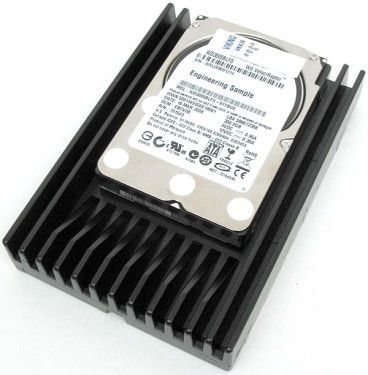From our front-page news:
It's been quite some time since Western Digital has issued a follow-up to their Raptor line-up, but that happens now, with the help of their "VelociRaptor" VR150 drive. What's this mean to you? More space, faster speeds, quieter operation and oddly enough, lower power consumption.
The biggest issue with previous EL150 drives was their density. Granted, 10K RPM is undoubtedly fast, but when you only get a maximum of 150 GB out of the drive, it's a definite trade off. Most things were done right with the VR150, however. Despite being physically smaller (2.5" compared to 3.5"), it has faster seek times, higher data rates and as I mentioned, lower power consumption. It seems like the perfect drive.
But even at 300 GB, there are a few issues. The first is the price, at $1 per GB. The second is that the drive utilizes a 16 MB Cache, whereas most other high-end desktop drives use 32 MB. What differences could be seen are unknown, but it would have been a nice number regardless. Our friends at the Tech Report were so impressed with WD's new offering, it deserved their Editor's Choice award, so don't hesitate to take a look at their (exhaustive) review.
<table align="center"><tbody><tr><td>

Credit: Tech Report </td></tr></tbody></table>
The VelociRaptor offers excellent performance across a wide range of applications, but its most spectacular showing was easily with IOMeter's multi-user workloads. These workloads don't simulate typical desktop environments, of course, but they're the most demanding tests we run. And they make a heck of a case for an enterprise derivative of the VelociRaptor. The 2.5" form factor is perfect for rack-mount systems where the VelociRaptor's low power consumption and strong multi-user performance will surely be appreciated.
Source: Tech Report
The biggest issue with previous EL150 drives was their density. Granted, 10K RPM is undoubtedly fast, but when you only get a maximum of 150 GB out of the drive, it's a definite trade off. Most things were done right with the VR150, however. Despite being physically smaller (2.5" compared to 3.5"), it has faster seek times, higher data rates and as I mentioned, lower power consumption. It seems like the perfect drive.
But even at 300 GB, there are a few issues. The first is the price, at $1 per GB. The second is that the drive utilizes a 16 MB Cache, whereas most other high-end desktop drives use 32 MB. What differences could be seen are unknown, but it would have been a nice number regardless. Our friends at the Tech Report were so impressed with WD's new offering, it deserved their Editor's Choice award, so don't hesitate to take a look at their (exhaustive) review.
<table align="center"><tbody><tr><td>

Credit: Tech Report </td></tr></tbody></table>
The VelociRaptor offers excellent performance across a wide range of applications, but its most spectacular showing was easily with IOMeter's multi-user workloads. These workloads don't simulate typical desktop environments, of course, but they're the most demanding tests we run. And they make a heck of a case for an enterprise derivative of the VelociRaptor. The 2.5" form factor is perfect for rack-mount systems where the VelociRaptor's low power consumption and strong multi-user performance will surely be appreciated.
Source: Tech Report
